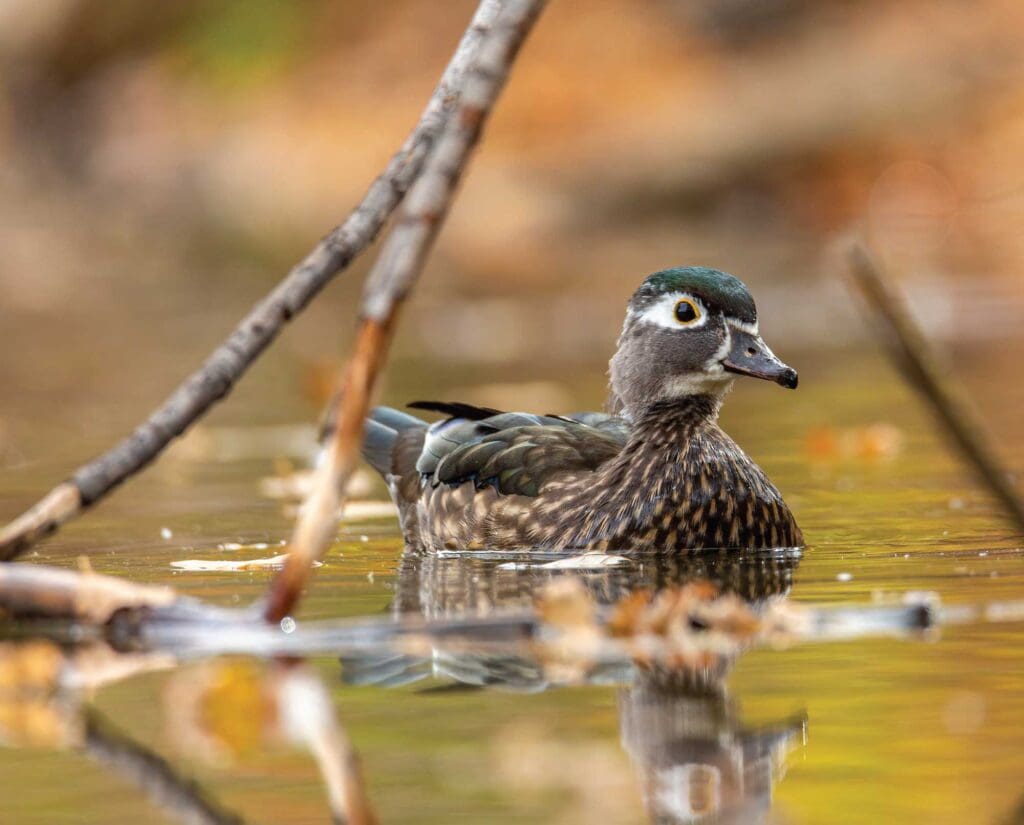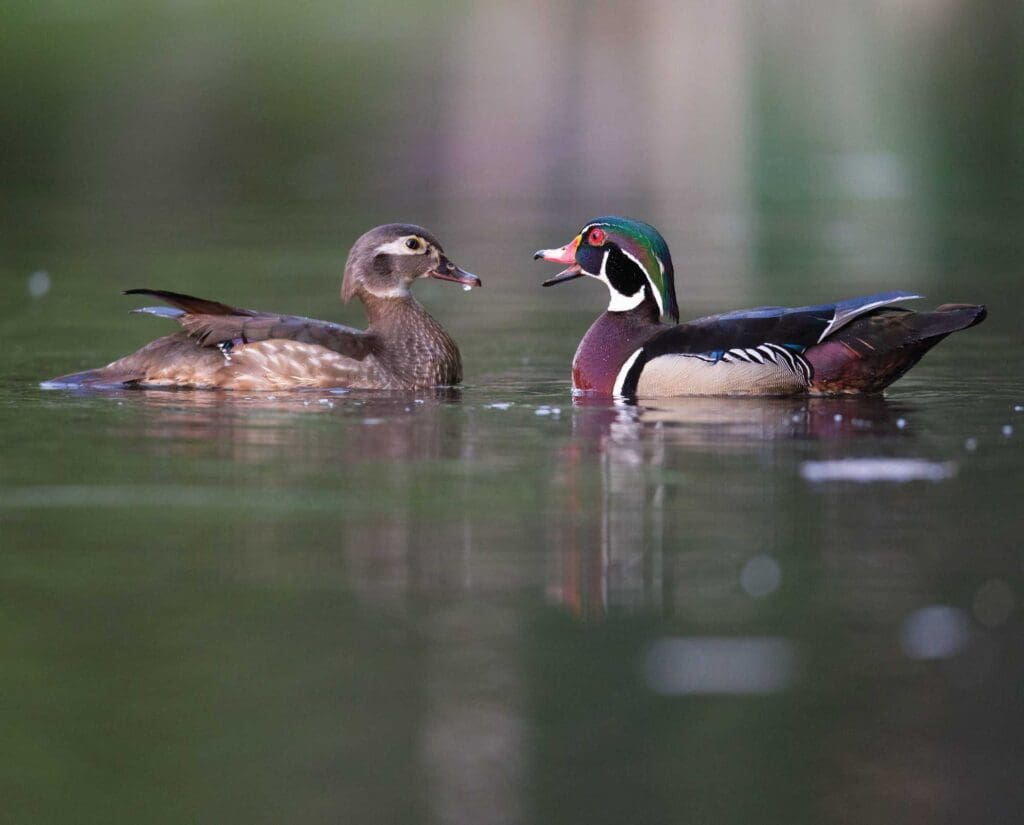Home » Waterfowl Hunting » Wood Duck Biology, Life History, and Identification
Wood Duck Biology, Life History, and Identification
- Climate Change Impact (Audubon) | +1.5°C - 16% Range Lost | +3.0°C - 30% Range Lost

Ryan Lisson is a biologist and regular content contributor to…
This visually stunning duck species is known for its forest dwellings and habitat
Although drake ducks are often more decorated than hens, the wood duck (Aix sponsa) drake puts the rest to shame. And honestly, the hen is pretty unique looking too. This gorgeous bird is somewhat unusual among ducks in terms of its nesting habits and tendency to perch in branches. In this profile, we’ll describe the basic characteristics, range, habitat, conservation issues and some hunting tips for the wood duck.
Description, Identification, and Life History of the Wood Duck
The wood duck is on the small side compared to the mallard, measuring about 18 inches in length and weighing about 1.5 pounds (NatureServe 2018). As with most ducks, drakes look very different from hens during the breeding season. They have a beautiful crested head, with iridescent green feathers striped with white and a splotch of reddish purple behind their bold, red eyes. Their bills are red and white, tipped with black. The bodies are just as stunning as the head, with rusty/chestnut colored breast feathers, a white throat patch, a tan and white belly and black wings, all with white and blue accents throughout (All About Birds 2018). Hens are much more subtle, with brownish body feathers and a slightly gray crested head. Their bills are usually a dark gray color and their eyes are dark surrounded by a ring of white feathers. Both sexes have muted yellow legs and feet, and brownish black wings with a dark blue wing patch (speculum) that is bordered with white.

Wood ducks start forming pairs in January with courtship displays that consist of the male displaying his feathers (All About Birds 2018). The pair will seek out a nest site in large tree cavities (especially if it is located near water sources) or artificial nesting boxes and line it with down feathers (National Audubon Society 2018). The hen will typically lay nine to 15 pale buff eggs and incubate them by herself for about 25 to 37 days (National Audubon Society 2018; NatureServe 2018). Hens may lay eggs in other hen nests as well – a behavior called egg dumping – to get the other hen to care for her eggs. Wood ducks are known for producing two broods each year in the South, and occasionally even in Northern breeding grounds (NatureServe 2018). The day after hatching, ducklings need to use their sharp claws to climb up out of the nest box or tree cavity which may be several feet deep (All About Birds 2018). Since wood ducks may choose tree cavities 50 feet high or more, the hatched ducklings have a long way to free fall to the forest floor – yet very few are injured in the process. The hen leads the ducklings to water, which may be up to one mile away (All About Birds 2018). The hen tends the ducklings until they can fly (at about 8 to 9 weeks) and then abandons them (NatureServe 2018).
Wood ducks are members of the dabbling duck group, which means they feed by floating in the water and submerging their head to graze, although they may make short dives underwater (All About Birds 2018). Primary natural food sources include seeds, nuts (especially acorns), leaves (e.g., smartweed, duckweed, water lily) and other mast (e.g., blackberries, wild cherries, etc.) (National Audubon Society 2018; All About Birds 2018). They also eat insects, crustaceans, and even frogs (NatureServe 2018). In agricultural fields, they will also eat waste grain (e.g., rice, millet, soybeans, etc.). Their feeding schedule peaks in the morning and afternoon.
Wood ducks experience a high annual mortality rate – up to 50 percent in adults and much higher in ducklings, likely due to the number of predators. Eggs and hatched ducklings are very susceptible to predation from mink, raccoons, snakes, snapping turtles, bullfrogs and many large fish (NatureServe 2018).
Range and Habitat of the Wood Duck
The wood duck is a migrant species, breeding in the northern part of the United States during the summer and retreating south to the Gulf or to the East and West Coasts for the winter. However, they do occur year-round in southern climates. Migrating pairs typically leave southern wintering grounds by mid-March and depart from northern breeding grounds by October or November (NatureServe 2018). Wood ducks are most common in the eastern half of the U.S., but some populations do occur along the West Coast and interior to Montana (National Audubon Society 2018).

The wood duck is a common inhabitant in shallow, freshwater areas, especially those that are surrounded by or in close proximity to forests (National Audubon Society 2018). Wooded swamps, flooded timber, beaver ponds, rivers, streams, and sloughs are all good places for them, especially if trees or shrubs overhang water sources (National Audubon Society 2018; All About Birds 2018). They may also utilize open marshes or emergent swamps in generally forested regions. While they prefer freshwater habitats, they may also winter on brackish waters. Ideal trees for nesting cavities include elms, maples and basswoods as these naturally develop cavities over time (NatureServe 2018).
Conservation Issues for the Wood Duck
The wood duck is listed as globally secure and of Least Concern by the IUCN Red List (NatureServe 2018). That’s good news because it wasn’t always that way. During the 19th century, the wood duck population suffered from market hunting and loss of nesting sites/habitat. Continued threats to wood ducks primarily include destruction of habitat (e.g., wetlands, especially forested wetlands). However, they have historically responded very well to artificial nesting boxes in the absence of natural tree cavities. To make your own, here are some wood duck box plans to supplement the nesting opportunities on your property.

Hunting Opportunities for the Wood Duck
The wood duck can be found across all four flyways (Pacific, Central, Mississippi and Atlantic). However, they aren’t as common throughout the Central flyway simply because the habitat types along it aren’t as optimum for the species. Besides mallards, wood ducks likely account for more harvests than other duck species. Here are a few wood duck hunting tips you can use this season.
Equipment and Bag Limits
Since wood ducks like to feed in wooded swamps, you’ll want a durable pair of waders to mitigate the chance of a sharp stick punching a hole in them. A 12- or 20-gauge shotgun would both work for these small to medium-sized ducks. If you want to use decoys, no more than a dozen would be necessary. As a migratory bird species, you’ll need a federal duck stamp to hunt wood ducks and will need to use non-toxic/non-lead shot.
Current daily bag limits for most duck species are six birds, no more than three of which can be wood ducks. The possession limit for all migratory birds is three times the daily bag limit (i.e., nine wood ducks).
Wood Duck Hunting Techniques
To effectively hunt wood ducks, there are a couple things you should keep in mind. First, wood ducks tend to be sensitive to hunting pressure. If you find a good number of woodies, be careful to not get greedy and over-hunt as it might push the others out of that area for the rest of the season. As with most duck hunting, it helps to do some pre-hunting scouting to know where the birds are hanging out. Silently sneak into the following areas to check them for duck activity before you hunt: streams and ponds with overhanging oak trees, picked grain fields, flooded bottomlands, etc. Make sure you are in position well before daylight, as wood ducks are often only active for the first several minutes of shooting light. You may want to toss a few decoys out to add some realism, but it’s not always necessary. Similarly, some people have luck calling them, while others just can’t put it together. If you’re not a particularly great caller, go without it. Another strategy that can work well for midday hunts (after the brief morning action) is to silently stalk streams and ponds and jump-shoot them. No matter how you choose to hunt them, there’s a lot to admire about the wood duck.
Ryan Lisson is a biologist and regular content contributor to several outdoor manufacturers, hunting shows, publications, and blogs. He is an avid small game, turkey, and whitetail hunter from northern Minnesota and loves managing habitat almost as much as hunting. Ryan is also passionate about helping other adults experience the outdoors for their first time, which spurred him to launch Zero to Hunt, a website devoted to mentoring new hunters.



